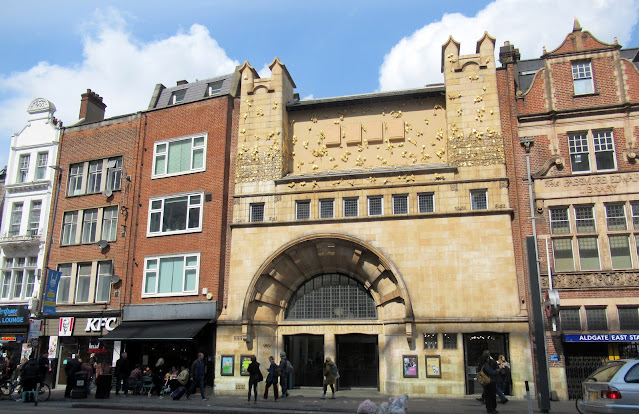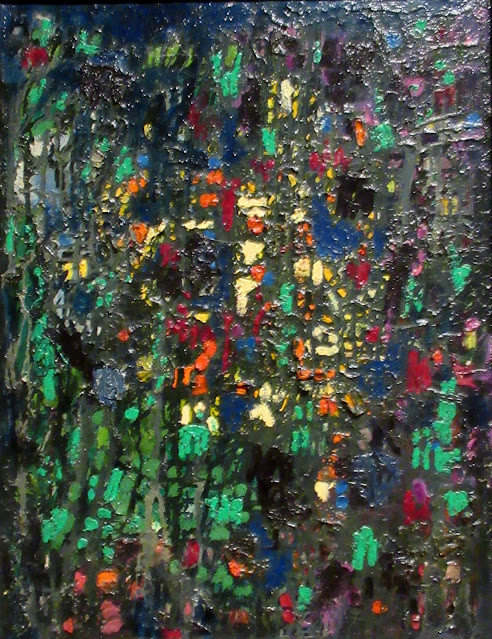Action, Gesture and Paint: Women Artists and Global Abstraction, 1940-70 at the Whitechapel Gallery.
An exhibition celebrating the women artists of mid-20th century gestural abstraction, showing how they shaped modern painting. The story of abstract art took a radical turn in the 1940s. Fusing bodily, gestural and emotive expression with colour, mark-making and the materiality of paint, this new movement was termed (in the USA) as Abstract Expressionism. It is often thought to have been centred in New York, where it was defined mainly by the work of white male artists. However, this new style of painting was a global phenomenon, shaped as much by local cultural and political context as by international exchange and dialogue.
The contributions of women have long been marginalised in modern art. The paintings presented here demonstrate how women across the world were fundamental in evolving the story of abstraction, incorporating experiences of turbulent social change into their work and promoting freedom of expression. Their art was made in a period of great historical shifts: the aftermath of WWII, global industrialisation, the rise of civil rights and post-colonial movements and a 'cold war' - marked by the threat of nuclear extinction - between capitalist democracies and communist states. Against this backdrop, the USA promoted abstract art as a form of western propaganda, to counter the influence of communism.
The exhibiton explores how artists made the canvas an arena for experimentation and personal expression through form and colour. It focuses on five themes: paint as material and process; symbolic languages drawn from myth and ritual; abstraction as an expression of the self; painting as movement and dance; and the canvas as environment.
The exhibition was divided into five sections and I have replicated this with my posts. There are five posts which mirror the sections of the exhibition, each with the same introduction.
Section 2: Myth, Symbol, Ritual:
The paintings in this section are characterised by systems of marks or forms that suggest a non-representational language - abstract signs and symbols that exist outside of place and time. Their origins lie in the legacies of European and Latin Amerian movements such as Surrealism, Taschisme and Art Informel. Spontaneous or 'automatic writing' was seen as a way of by-passing rationalism to access unconscious drives and desires. The artists here were also interested in non-western systems of belief and their expression through calligraphy and graffitti, as well as the symbols and glyphs associated with ancient myths and rituals.

Akiko Miyawaki, Japan, Work, 1962 (marble powder and oil on canvas)
Miyawaki experimented with heavily built-up surfaces made from layers of pigment mixed with marble powder over canvas on board, creating mixed-media works with undulating dune-like surfaces incorporating materials like glass. In 1966 she shifted towards sculpture, with her famous Utsurohi (transcience) series of swirling ductile stainless steel cords.
Tomie Ohtake, Japan/Brazil, Roxo (Purple), 1966, (oil on canvas)
Ohtake did not begin to paint until the age of 39. Consistently experimenting with form and process, Ohtake soon ventured from figurative painting into creating abstract shapes and colour fields.
Tomie Ohtake, Untitled, 1960, (oil on canvas)
Lee Krasner, USA, Bald Eagle, 1955, (oil, paper and canvas collage on linen)
One of the defining figures of the first generations of Abstract Expressionists in New York. Her series of Little Images and collage paintings included fragments of discarded paintings which she let fall onto the surface of the canvas.
Lee Krasner, Feathering, 1959, (oil on canvas)
Charlotte Park, Jubilee, 1955, (oil on canvas)
Ethel Schwabacher, USA, Woman: Red Sea, Dead Sea, 1951, (oil on canvas)
Grace Hartigan, USA, Cedar Bar, 1951, (oil on canvas)
Hartigan was part of the dynamic group known as the second generation of Abstract Expressionists, which also included her friends Helen Frankenthaler and Joan Mitchell. In the 1950s she used the name George, which she attributed to her admiration for 19th century women writers George Eliot and George Sand.
George Hartigan, Portrait of W, 1951-52, (oil on canvas)
Franciszka Themerson, Poland/UK, Calligramme, 1960, (red emulsion and black enamel on paper)
Themerson created what she described as 'Bi-abstract pictures' using plaster and cloth in relief works and poured enamel paint onto paper in improvised drawings relying on chance.
Franciszka Themerson, Poland/UK, Calligramme, 1960, (red emulsion and black enamel on paper)
Franciszka Themerson, Poland/UK, Calligramme, 1960, (red emulsion and black enamel on paper)
Franciszka Themerson, Poland/UK, Calligramme, 1960, (red emulsion and black enamel on paper)
Franciszka Themerson, Poland/UK, Calligramme, 1960, (red emulsion and black enamel on paper)
Behjat Sadr, Untitled, 1956, (oil on canvas)
Judit Reigt, Hungary/France, Mass Writing, 1961, (oil on canvas)
When Reigt moved to Paris she met Andre Breton and was influenced by Surrealist ideas, particularly the technique of automatic writing that remained substantial throughout her career. Later she moved towards lyrical abstraction, in work that emphasised the gestural involvement of the body when painting.
Betty Parsons, USA, Looking Out, 1957, (oil on canvas)
Buffie Johnson, USA, Pentecost, 1958, (oil on canvas)
Sarah Grilo, Argentina/Spain, Black Wall, 1967, (oil on canvas)
Grilo was a member of the Grupo de Artistas Modernos who explored geometric abstraction in 1950s Buenos Aires. After the group dissolved she travelled to Europe, then moved to New York in 1962, where she developed a more gestural and lyrical informal abstraction using letters, numbers and symbols drawn from torn posters, signs and graffitied walls she observed on the streets.
Maliheh Afnan, Palestine, Concours, 1961, (oil on canvas)
Afnan was part of an important generation of female artists and writers who emerged in the Middle East in the new cultural climate of the 1960s. Her work touches on post-war themes of exile and memory, based on her and her family's experience being exiled from Palestine in 1948. Interested in Arabic and Persian scripts, she transformed these in her 'written paintings' into abstract forms, creating a visual caligraphic language concerned with memory and feelings of loss and displacement.
Vivian Springford, Untitled, 1962, (acrylic on canvas)
Sarah Grilo, Switzerland, Not Even One More Day, 1966, (oil on canvas)
Nadia Saikali, Moonrise, 1969, (oil on canvas)
Nadia Saikali, France, Gesture, 1960, (oil on canvas)
Saikali's interest in abstraction grew from a love of geography and geology, ancient civilisations and archaeology, which inform her mark-making and fluid gestures.
Helen Khal, USA/Lebanon, Ochre Over Brown, 1968, (oil on canvas)
Khal's paintings contain fluid blocks of colour in intimately scaled abstract works infused with light which she described as a way to create 'an oasis for the emotions'. In 1975, she published the influential feminist book, The Woman Artist in Lebanon.
Chinyee, China, Solids, 1964, (oil on canvas)
Nina Tryggvadottir, Iceland, Abstraction, 1963, (oil on linen)
Tryggvadottir was a painter but also employed collage, stained glass and mosaic. Her compositions referenced nature, Icelandic landscapes and Nordic light.
Elna Fonnesbech-Sandbert, Denmark, Myriader, 1959, (oil on canvas)
Fonnesbech-Sandberg was a Danish artist, collector an patron who, during the 1920s, built up a unique art collection of Scandinavian modernism. Following WWII, she shifted her focus to collect expressive abstract art. Fonnesbech-Sandberg started painting in 1947 at the request of her psychoanalyst, quickly developing a densely layered, abstract style consisting of numerous layers of paint that she then scratched through and repainted again and again.
Britta Ringvall, Sweden, Swedish Landscape, 1960, (oil on canvas)
Hedwig Thun, Germany, Dodona, 1962, (oil on canvas)
Thun's early works were figurative, and she turned to abstraction while a student at the Bauhaus school, where her early compositions show a similarity to her teacher Wassily Kadinsky. From 1950 onwards, Thun's works became more gestural as she experimented with various stain and drip techniques.
Carol Rama, Italy, (We moan, we do the Bop), 1868, (pigmented glue and dolls' eyes on card)
































No comments:
Post a Comment